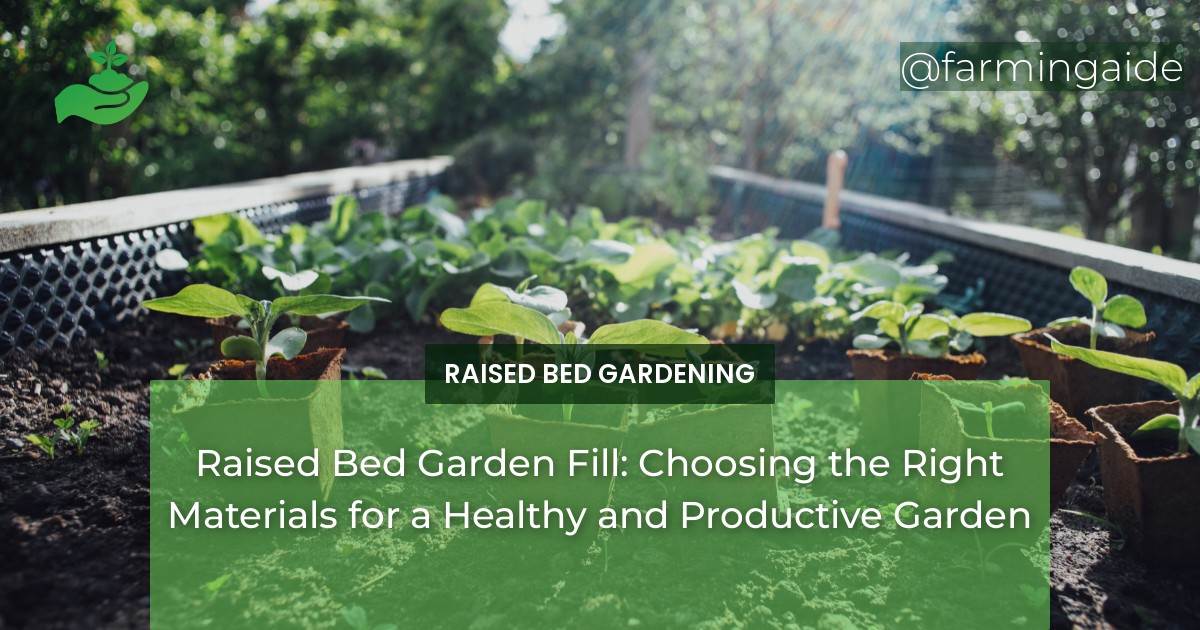A raised bed garden is a popular and efficient way to grow a variety of plants in a small space. However, the success of a raised bed garden greatly depends on the type of fill used. Choosing the right materials for a raised bed garden can have a significant impact on plant growth, environmental sustainability, and cost-effectiveness.
In this article, we will explore the importance of selecting the right raised garden bed fill and provide tips for filling and maintaining a healthy and productive garden.
Table of Contents
Importance of Choosing the Right Fill for a Raised Bed Garden
Enhanced Plant Growth and Health
One of the main reasons for using a raised bed garden is to provide optimal growing conditions for plants. The right fill can greatly enhance plant growth and health in several ways:
- Improved drainage and aeration: Raised beds allow for better drainage and aeration compared to traditional gardens. The right fill can further improve these conditions, allowing for better root development and nutrient uptake.
- Nutrient-rich soil: Plants need a variety of nutrients to thrive, and the right fill can provide a balanced mix of essential nutrients for healthy growth.
- Optimal pH levels: Different plants have different pH preferences, and the right fill can help maintain the ideal pH levels for specific plants.
- Minimizing weed growth: The right fill can help suppress weed growth, reducing competition for nutrients and water.
Environmental Sustainability
Using the right fill for a raised bed garden can also have a positive impact on the environment. Some ways in which the right fill promotes sustainability include:
- Reduction of waste and landfill use: By using materials that would otherwise end up in landfills, such as compost and manure, gardeners can reduce waste and promote a circular economy.
- Utilizing local and sustainable materials: Choosing materials that are locally sourced and sustainable can reduce the carbon footprint of a garden and support local businesses.
- Promoting biodiversity and soil health: The right fill can help create a diverse and healthy ecosystem in the garden, supporting beneficial insects and microorganisms that contribute to soil health.
ALSO READ
Cost-Effectiveness
In addition to promoting plant growth and environmental sustainability, the right fill can also save gardeners money in the long run. Some cost-effective benefits of using the right fill include:
- Long-term savings on fertilizers and pesticides: By providing plants with the necessary nutrients and promoting a healthy ecosystem, the right fill can reduce the need for expensive fertilizers and pesticides.
- Reduced labor and maintenance costs: With improved drainage and weed suppression, gardeners can spend less time and effort on maintenance tasks.
- Potential for DIY options: Some materials, such as compost and leaf litter, can be easily made at home, providing a cost-effective option for filling a raised bed garden.
Types of Fill and Their Uses
There are various types of fill that can be used in a raised bed garden, each with its own benefits and uses. Some common types of fill include organic materials, inorganic materials, and blended materials.
Organic Materials
Organic materials, such as compost, manure, and leaf litter, are popular choices for filling raised beds. These materials are nutrient-rich and can improve soil structure, making them ideal for organic gardening practices. However, they may not be suitable for all plants and soil types, so it is essential to research and consider the specific needs of your garden before using organic materials.
Inorganic Materials
Inorganic materials, such as gravel, sand, and perlite, are often used to improve drainage and aeration in raised beds. These materials are suitable for specific plant needs and soil types, making them a versatile option for filling a raised bed garden. However, they may not provide the necessary nutrients for plant growth, so it is essential to supplement with organic materials or fertilizers as needed.
Blended Materials
Blended materials, such as topsoil, peat moss, and vermiculite, offer a balanced combination of organic and inorganic materials. This makes them an ideal choice for most raised bed gardens, providing both nutrients and improved soil structure. However, they may be more expensive than other options, so it is essential to consider the cost-effectiveness of using blended materials.
ALSO READ
Tips for Filling and Maintaining a Raised Bed Garden
Once you have chosen the right fill for your raised bed garden, it is essential to properly fill and maintain the garden for optimal results. Here are some tips to keep in mind:
- Measure and calculate the amount of fill needed: It is crucial to accurately measure the dimensions of your raised bed and calculate the amount of fill needed to avoid over or underfilling.
- Layer materials for balanced nutrients and soil structure: Layering different types of fill can provide a balanced mix of nutrients and improve soil structure for optimal plant growth.
- Use quality materials to avoid contamination and pests: It is essential to use high-quality materials to avoid contamination and pests that can harm plant growth.
- Regularly test and amend soil as needed: Over time, the nutrients in the fill may become depleted, so it is essential to regularly test and amend the soil to maintain optimal growing conditions.
- Mulch and rotate crops to maintain soil health: Mulching can help retain moisture and suppress weed growth, while crop rotation can help maintain soil health and prevent nutrient depletion.
Conclusion
A raised bed garden fill is a crucial element for a successful and sustainable garden. By carefully selecting and maintaining the right materials, gardeners can enjoy a healthy and productive garden for years to come. Remember to research and consider the specific needs of your plants and soil type, and always prioritize environmental sustainability and cost-effectiveness.
RELATED ARTICLES:


